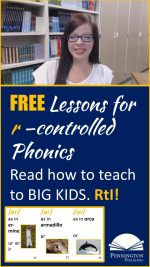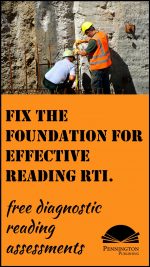“Differentiation is simply a teacher attending to the learning needs of a particular student or small groups of students, rather than teaching a class as though all individuals in it were basically alike.”
“The idea of differentiating instruction to accommodate the different ways that students learn involves a hefty dose of common sense, as well as sturdy support in the theory and research of education (Tomlinson & Allan, 2000). It is an approach to teaching that advocates active planning for student differences in classrooms.”
—Carol Ann Tomlinson (2000)
Most advocates of differentiated instruction (DI) would certainly agree with Carol’s definition. However, educators who venture much beyond that simple statement may quickly part paths with their colleagues regarding how best to accomplish that mission in the classroom. DI is certainly not an easily-identified, monolithic movement. Indeed, the movement is multi-faceted.
Educational organizations, publishers, researchers, and presenters have jumped on the DI bandwagon over the last dozen years and DI is now big business. Everyone tends to define DI in ways that best suit their pedagogical presuppositions and/or interests. However, the basic principles of DI cannot be co-opted by any group because DI is fundamentally just good teaching.
With Response to Intervention (RTI) now taking center stage throughout many school districts today, it is increasingly important to shed light on some of the key myths of DI. Teachers who have resisted implementing DI because of these myths may be encouraged to re-visit how they teach their students.
Educational Philosophy
1. Contrary to popular belief, differentiated instruction has not been completely kidnapped by constructivists. Constructivism is an educational philosophy predicated on the belief that learning occurs best when students construct their own “rules,” “mental models,” and “meaning-making” to integrate new experiences into their existing schemata and prior knowledge. As applied to differentiated instruction, constructivists including the likes of Carol Ann Tomlinson, Amy Benjamin, and Rick Wormeli, believe that students should be provided multiple options for taking in information and making sense of ideas and that teachers must adapt the curriculum or mode of instruction to the student. Many DI teachers fundamentally disagree with constructivism and believe that trained and informed teaching professionals make the best choices regarding what and how their students need to learn.
2. No, Howard Gardner did not invent DI. The theory of multiple intelligences has lost favor over the last few years. No brain scientist has yet found a “musical intelligence” section in the cerebral cortex. Many teachers who differentiate instruction do believe that students who haven’t yet learned certain skills need to be taught differently, but not necessarily because those students lacked a particular form of “intelligence” and, instead, need to learn via another of the seven intelligences.
3. Learning styles, multi-sensory instruction, and the importance of environmental preferences are long-standing educational constructs. All are based upon minimal research. Still popular with special education teachers, learning style inventories do not provide reliable diagnostics about how to differentiate instruction. Auditory and visual processing deficits can be diagnosed, but no research has yet demonstrated which instructional strategies work best for these learners.
Instructional Strategies
4. Some teachers and administrators reject DI because of the mistaken belief that DI rejects direct instruction. Nothing could be further from the truth. Much of DI instruction involves direct, explicit instruction as in pre-teaching concepts and/or skills or direct whole class instruction followed by small group and/or individual review.
5. A commonly held belief is that there is only one way to differentiate instruction and that is through small groups: heterogeneous cooperative groups or homogeneous ability groups. Small groups are certainly key DI instructional strategies, but not the only ones.
6. Many veteran teachers or special education teachers think that DI means individualized instruction. Some picture SRA® reading kits with color-coded reading comprehension cards and individual students anxiously lining up to have their work corrected by the teacher to see if they will advance to the “silver” level. Some DI teachers do individualize instruction, but many prefer other instructional methods.
7. Some teachers equate DI with open-ended assignments that focus on self-exploration, based upon student choice, such as with some components of Learning Centers or Writers Workshop. Some assume that DI classrooms are Montessori®-style “open classrooms” with self-guided, unstructured learning. Students only learn when the task is perceived as being meaningful or relevant. In other words, the curriculum is defined by the student. Actually, most successful DI teachers are excellent classroom managers, are extremely organized, and are very much in charge of student learning and the curricular content. DI classrooms may be student-centered, but they are very much teacher-directed.
8. Some have heard that problem solving, critical thinking, inquiry learning, and “big picture” learning are key features of a DI classroom. Some see visions of classrooms plastered with Bloom’s Taxonomy and Costa’s Levels of Questioning posters. Good differentiated instruction challenges students of all levels at all levels of thinking, but these characteristics and/or instructional methodologies are not exclusive to a DI classroom.
9. Interdisciplinary thematic instruction is not joined at the hip with DI. The flexibility and cross-over potential of this instructional approach may lend itself to DI strategies, but there is no necessary connection in the way that some advocates insist.
10. The authentic assessments movement has no hand-in-glove connection with DI. Some teachers who differentiate instruction do use authentic assessments; some do not. DI does not necessitate varying assessments according to the preference and/or perceived needs of individual students.
11. Many think that the “basics” are ignored in a DI classroom. Some have heard that only whole-to-part, deductive reasoning and learning are emphasized. Nothing could be further from the truth. Much of differentiated instruction is skill-centered and inductively builds knowledge through layers of learning from basic to more complex, from part-to-whole.
12. Many teachers believe that DI requires different instruction, different assessments, different grading, and different assignments for different students. Actually, most DI teachers use the same instructional methodologies, the same assessments, the same grading system, and many of the same assignments for all of their students. Teachers may emphasize different instructional components, but many of the tools are the same for all students.
Who Receives Differentiated Instruction
13. “DI is only for students with learning disabilities,” some say. “Every child must have an Individualized Education Program (IEP) and teachers are held accountable for adapting their instruction to the prescribed needs of each student. Response to Intervention (RTI) is all about the procedures to ensure that these IEPs are enforced.” Not true. Although “mainstreaming” or “full inclusion” models have placed students with identified (IEP) learning disabilities or special needs students back into the classroom, DI is not just for these students. DI is for every student.
14. “DI is only for heterogeneously mixed classes, not for tracked programs including remedial (intervention), regular, and accelerated (honors) divisions.” One of most ubiquitous beliefs about DI is the erroneous assumption that it is only intended for diverse classrooms. Although many teachers who practice DI fundamentally disagree with tracking, differentiated instruction deals with meeting the needs of individual students, not groups, per se. Thus, many teachers practice DI in very homogeneous settings.
15. “DI is forced upon teachers to meet the needs of Gifted and Talented Education (GATE) students in order to qualify for state funding.” There may be isolated situations in which teachers are required to differentiate instruction because they have identified gifted students in their classes; however, this would certainly be the exception, not the rule.
Curricular Rigor and Fairness
16. Advocates of DI may be surprised to hear that many think that DI eliminates standardized curriculum and cannot be standards-based. Actually, DI can be used to “catch up,” “keep up,” and “move ahead” students in reference to grade-level standards. In fact, teachers practicing DI usually reference their diagnostic and formative assessments to an established instructional scope and sequence, based upon state standards.
17. Some teachers, parents, and administrators think that DI “dumbs-down” the level of classroom instruction because kind-hearted teachers are loathe to “leave any child behind” and will slow the pace of instruction or adjust curriculum accordingly to ensure “success for all.” Actually, DI teachers tend to focus more on individual mastery of established objectives and less on whole-class mastery. Teachers who do not practice DI are more likely to “teach to the center,” in terms of the academic abilities of their students.
18. Many teachers believe that DI “pigeon-holes” students and lowers their self-esteem. Because DI does involve frequent diagnostic and formative assessment to adjust instruction to the needs of the learners, students become well-aware of their relative strengths and weaknesses in given academic areas. Instructional practices, such as flexible ability grouping, can contribute to this potential problem. However, sensitive and well-trained teachers need not succumb to creating negative self-concepts in their classrooms. And, pretending that students do not have different abilities and levels of skills mastery will not increase self-esteem. Improved self-concept, at least in part, derives from increasing expertise and reaching individual goals—exactly the instructional foci of differentiated instruction. Instead of lowering expectations by ignoring individual differences, DI raises expectations for individual students.
19. Some think that DI is inherently undemocratic. They say that the bright students or students with a strong work ethic get extra work or open-ended assignments to keep them busy while “freeing up” the teacher to spend more of her time addressing the needs of underperforming students, who get “modified” assignments, i.e. less work than “regular” or “accelerated” students. Or, worse yet, the bright students are recruited as peer tutors. Thus, industriousness is rewarded with more work and laziness is rewarded with less work. And grading is adjusted as the capstone to these foundational inequities. There may be some truth to this myth in many DI classrooms. The over-arching issue of fairness and how fairness is applied within the walls of the classroom reflect teachers’ personal political and pedagogical philosophies. Some, for example, would argue that it is inherently unfair that students are ill-prepared for their grade-level instruction through no fault of their own.
20. Students who are the beneficiaries of DI won’t be able to compete in the real world. Students not used to working to the highest standards will be ill prepared for gateway tests, such as the SAT® and ACT®. If students aren’t exposed to challenging, high-level skills and concepts, they will be doomed to failure. Actually, DI teachers try to bridge the gap between basic and advanced skills and concepts. They design instruction to help students “keep up” while “catching up.”
Teacher Commitment
21. Some teachers resist DI because they wrongly perceive that managing diverse instructional strategies and on-going assessments takes a genius. However, teachers of all ability and experience levels can begin differentiated instruction with proper training and support. Furthermore, DI is not an “all or nothing” proposition. Most teachers layer in different aspects of DI over years of instruction.
22. Some say that DI requires way too much preparation, assessment, correction, and record-keeping. This may have been a truism years ago, but clever teachers have since developed effective short-cuts to planning, assessment, and paper work. DI need not be a cause of teacher “burn-out.”
23. Some proponents of DI intimate that differentiated instruction solves all educational problems and ensures student mastery of key concepts and skills. However, you “can lead a horse to water, but you can’t always make him drink.” Some students exposed to the best DI will continue to fail.
Reading, Study Skills
Amy Benjamin, Carol Ann Tomlinson, cooperative groups, DI, differentiated instruction, differentiated learning, differentiated reading instruction, grouping, individualized instruction, instructional differentiation, Mark Pennington, mastery learning, reading intervention, Rick Wormeli, tracking
![]()

![]()


